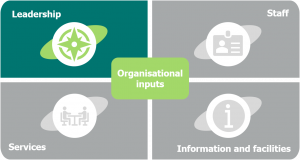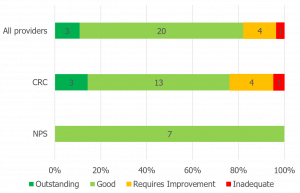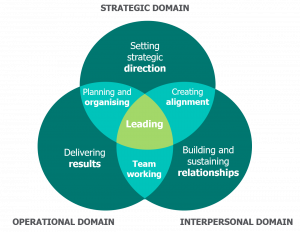Leadership

Key findings
- Effective leadership, with a focus on staff wellbeing and engagement, improves staff motivation and organisational results.
- Leaders should set out a clear vision and strategy which is compelling, authentic and grounded in evidence, and the organisation’s culture should be one of involvement, transparency, ownership, empowerment and improvement. Clear and timely communication is key.
- There must be clear divisions of responsibility and accountability, enabling people to collaborate and work together effectively.
- A collaborative and outward-looking approach should be taken to working with other organisations, with a common focus on improving the quality of delivery through service user-centred practice.
- Leaders must be aware of current and future challenges for the organisation, both short and long term, and be proactive in assessing risks and acting to prevent them.
- Cynicism amongst staff members can be a barrier to organisational change, and can be countered through a promotion of employee voice and co-creation, authentic (realistic and honest) and coherent explanation about the need for change, and leaders showing that they have a realistic understanding of the challenges.
Background
Inspirational leadership: A quality attributed to leaders who are able to create a culture of motivation and commitment. Inspiring leaders aim to create an environment of trust in which people can be creative and motivated to fulfil their potential. They tend to: have passion; have a sense of purpose; be honest and trustworthy; encourage others to share their vision; inspire others to achieve their potential.
(The Investors in People Standard)
Organisational design models and frameworks (such as the EFQM Excellence Model – see video below), informed by reviews of the evidence and the latest learning and practical experience, consistently highlight the importance of leadership to high levels of employee engagement and performance.
Disclaimer: an external platform has been used to host this video. Recommendations for further viewing may appear at the end of the video and are beyond our control.
Another specific model is the Primary Colours Model – summarised in the figure below. In the central zone, the enablers of leadership are described in five verbs:
- Inspire
- Focus
- Enable
- Reinforce
- Learn
‘Leadership style’ describes how a leader relates to others, how they give direction, how they deliver projects, and how they motivate teams. Leadership styles are described by business theorists as being on a continuum from directive/authoritarian to participative/democratic. ‘Transformational leadership’ is a commonly recommended leadership style, characterised by:
- being a model of integrity and fairness
- setting clear goals
- having high expectations
- encouraging others
- providing support and recognition
- stimulating the emotions of people
- motivating people to look beyond their self-interest
- inspiring people to reach for the improbable.
Summary of the evidence
Key characteristics
International evidence indicates that successful organisations are associated with organisational cultures that stress employee involvement, transparency, empowerment and improvement. Leaders who actively and consistently listen to staff and explain their decisions are more likely to lead higher performing organisations in terms of productivity, satisfaction, and staff retention and absenteeism. Leaders must set out a clear vision and strategy which is compelling, authentic and grounded in evidence, and staff should feel empowered to come up with new ideas and to challenge the status quo to improve the organisation’s performance. The experiences and views of service users should also be monitored and reviewed. Progress against the strategy must then be proactively and regularly reviewed, with leaders continually striving to deliver and develop the strategy. Evidence-informed innovation should be championed and celebrated.
Working together
Leaders must establish organisational models which enable personalised delivery for service users – the evidence is clear that one-size-fits-all processes and interventions will not work – and continuity of contact, helping to build the trusting personal relationships which can be a powerful vehicle for change. To ensure that the service user receives integrated support, and to maximise the use of resources, there must be clear divisions of responsibility and accountability, so that it is clear who is doing what and at which point, and how roles enable people to collaborate and work together effectively.
Working with others
A collaborative and outward-looking approach should be taken to working with other organisations, maximising the benefits for service users through the appropriate exchange of expertise, resources and knowledge. There should be a common focus on improving the quality of delivery through service user-centred practice, with all organisations knowing what is expected of each other. Representation on relevant strategic groups is required, with representation being consistent and those attending demonstrating appropriate decision-making authority.
Challenges and change
Leaders must be aware of current and future challenges for the organisation, both short and long term, and be proactive in assessing risks and acting to prevent them. Appropriate mitigations should be in place, which are adjusted as necessary over time. Staff at all levels should be actively encouraged to raise concerns and those who do should be supported. There should be clear and regular two-way communication, with leaders having a strong track record of listening to staff concerns and acting on them in a timely, responsive manner.
There should be adequate employee consultation on changes, with opportunities provided for employees to influence proposals. Once again, communication is key – where changes are required, they should be communicated in a timely and transparent way across the organisation, with a clear proactive approach to embedding and monitoring new ways of working. Cynicism amongst staff members can be a barrier to organisational change, and can be countered through:
- an authentic – realistic and honest – and coherent explanation about the need for change transmitted through all levels of management
- developing and deploying transformational leadership skills, especially those skills around relationships with the employees (leader-manager-employee closeness is a key predictor of influence)
- promoting employee voice and co-creation around organisational change
- helping staff understand the consequences of failure
- leaders showing that they have a realistic understanding of the challenges being faced by employees.
In our 2018/2019 inspections of probation providers, we considered whether the leadership within each organisation supported and promoted the delivery of a high-quality, personalised and responsive service for all service users. Across the 28 inspections, three providers received an ‘Outstanding’ rating, with twenty receiving a ‘Good’ rating (including all seven NPS divisions), four rated as ‘Requires improvement’, and one rated as ‘Inadequate’.

Collins, J. (2005). Built to Last: Successful Habits of Visionary Companies. New York: Random House Business.
Council of Europe (2010). Recommendation CM/Rec (2010)1 of the Committee of Ministers to member states on the Council of Europe Probation Rules.
Council of Europe (2010). Explanatory Memorandum on the Council of Europe Probation Rules.
Customer Service Excellence (2012). The Customer Service Excellence Standard. London: Customer Service Excellence.
EFQM (2012). EFQM Excellence Model. Brussels: EFQM.
Engage for Success (2014). The Evidence: Wellbeing and Employee Engagement.
Investors in People (2015). The Standard. London: Investors in People.
Pendleton, D. and Furnham, A. (2016). Leadership: All you need to know. Basingstoke: Palgrave Macmillan.
Back to Organisational delivery Next: Staff
Last updated: 18 December 2020




